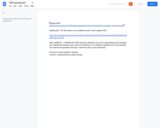
Use this assignment to help analyze a photograph on a deeper level and get a better understanding of media literacy.
- Subject:
- Education
- Material Type:
- Activity/Lab
- Homework/Assignment
- Date Added:
- 11/21/2021

Use this assignment to help analyze a photograph on a deeper level and get a better understanding of media literacy.

This course focuses on alternative ways in which the issues of growth, restructuring, innovation, knowledge, learning, and accounting and measurements can be examined, covering both industrialized and emerging countries. We give special emphasis to recent transformations in regional economies throughout the world and to the implications these changes have for the theories and research methods used in spatial economic analyses. Readings will relate mainly to the United States, but we cover pertinent material on foreign countries in lectures.
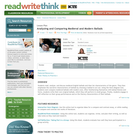
Students explore the ballads genre by reading medieval ballads to deduce their characteristics, acting out the ballads, comparing medieval and modern ballads using Venn diagrams, and composing their own ballads.

Students will analyze photos for specific details that reveal the owner of a specific room.Then the analysis will include literature but will focus on literary devices and connotations.Also, students will have the opportunity to summarize text and then use evidence to support specific connotations.
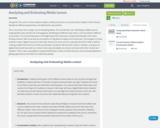
The goal for this unit is to have students analyze a variety of sources on a current events subject of their interest, identify the different perspectives, and defend their own position.This is one lesson from a larger unit on Evaluating Media. This unit will also cover identifying credible sources, analyzing fake news and the role of propaganda, identifying the different ways news is communicated in different communities. This unit will take place in the beginning of the school year to help instill evaluative and critical thinking research skills as we discuss and explore our big ideas throughout the school year. The end goal is to have students create a digital resource for their topic that we can share out as an educational tool for others. We’ll be creating a padlet that links to all of their presentations (students will have their choice in medium, as long as it is digital) that we will share with our school community and ideally can connect and share with other schools and students. There is also a possibility of using PenPalSchools to share out final resources, but that would depend on getting approval from the district to utilize that website.
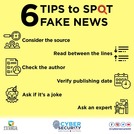
The goal for this unit is to have students analyze a variety of sources on a current events subject of their interest, identify the different perspectives, and defend their own position.This is one lesson from a larger unit on Evaluating Media. This unit will also cover identifying credible sources, analyzing fake news and the role of propaganda, identifying the different ways news is communicated in different communities. This unit will take place in the beginning of the school year to help instill evaluative and critical thinking research skills as we discuss and explore our big ideas throughout the school year. The end goal is to have students create a digital resource for their topic that we can share out as an educational tool for others. We’ll be creating a padlet that links to all of their presentations (students will have their choice in medium, as long as it is digital) that we will share with our school community and ideally can connect and share with other schools and students. There is also a possibility of using PenPalSchools to share out final resources, but that would depend on getting approval from the district to utilize that website.
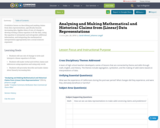
A statistics lesson on describing and making claims from data representations, specifically linearly increasing data. Applies ideas of rate-of-change to develop writing a linear equation to fit the data, using the equation to interpolate and extrapolate additional information, and integrating the mathematical interpretation appropriately into a social sciences argument.

Students analyze images of Oscar Wilde used to publicize his 1882 American lecture tour. They then compare a caricature to another researched image, sharing this analysis in a podcast.
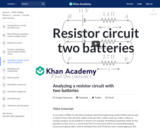
An example of simplifying a seemingly complicated resistor circuit. Created by Willy McAllister.
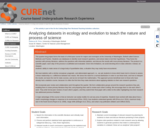
This quarter-long project forms the basis of a third-year course for majors and nonmajors at the University of Washington, Bothell called Science Methods and Practice. Students use databases to identify novel research questions, and extract data to test their hypotheses. They frame the question with primary literature, address the questions with inferential statistics, and discuss the results with more primary literature. The product is a scientific paper; each step of the process is scaffolded and evaluated. Given time limitations, we avoid devoting time to data collection; instead, we sharpen
students' ability to make sense of a large body of quantitative data, a situation they may rarely have encountered.
We treat statistics with a strictly conceptual, pragmatic, and abbreviated approach; i.e., we ask students to know which basic test to choose to assess a linear relationship vs. a difference between two means. We stress the need for a normal distribution
in order to use these tests, and how to interpret the results; we leave the rest for stats courses, and we do not teach the mathematics. This approach proves beneficial even to those who have already had a statistics course, because it is often the first time
they make decisions about applying statistics to their own research questions.
We incorporate peer review and collaborative work throughout the quarter. We form collaborative groups around the research questions they ask, enabling them to share primary literature they find, and preparing them well to review each other's writing. We encourage them to cite each other's work. They write formal peer reviews of each other's papers, and they submit their final paper with a letter-to-the-editor highlighting how their research has addressed previous feedback.
A major advantage of this course is that an instructor can easily modify it to suit any area of expertise. Students have worked with data about how a snail's morphology changes in response to its environment (Price, 2012), how students understand genetic drift (Price et al. 2014), maximum body size in the fossil record (Payne et al. 2008), range shifts (Ettinger et al. 2011), and urban crop pollination (Waters and Clifford 2014).
(Note: this resource was added to OER Commons as part of a batch upload of over 2,200 records. If you notice an issue with the quality of the metadata, please let us know by using the 'report' button and we will flag it for consideration.)
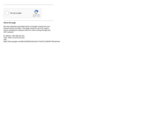
Checklist that can be used as a guide in analyzing the assignment examples

This book provides an introduction to the study of meaning in human language, from a linguistic perspective. It covers a fairly broad range of topics, including lexical semantics, compositional semantics, and pragmatics. The chapters are organized into six units: (1) Foundational concepts; (2) Word meanings; (3) Implicature (including indirect speech acts); (4) Compositional semantics; (5) Modals, conditionals, and causation; (6) Tense & aspect.
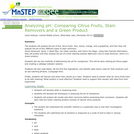
This activity will introduce pH testing of cleaning products, citrus fruits, and then analyzes a mystery Green product. Students will compare and contrast findings to discover an earth friendly product.
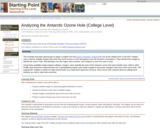
College-level adaptation of a chapter in the Earth Exploration Toolbook. Examine satellite images of atmospheric ozone in the Southern Hemisphere to study changes in concentration over a time.
(Note: this resource was added to OER Commons as part of a batch upload of over 2,200 records. If you notice an issue with the quality of the metadata, please let us know by using the 'report' button and we will flag it for consideration.)
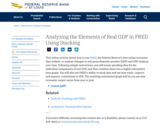
This online activity shows how to use FRED, the Federal Reserve's free online economic data website, to analyze changes in real gross domestic product (GDP) and GDP makeup over time. Following simple instructions, you will locate spending data for the individual components of real GDP, and then combine them into a highly informative area graph. You will also use FRED's ability to stack data and see how trade—imports and exports—contributes to GDP. The resulting customized graph will let you see how economic output varies from year to year.
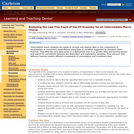
Intermediate students are asked to analyze data on the components of consumption and investment expenditures and explanatory variables based on textbook models of each. Students look for rough correlations between the explanatory and dependent variables.
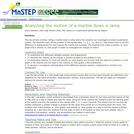
This lab activity has students rolling a marble down a ramp to study position, velocity, and acceleration. Based on a experiment performed by Galileo.
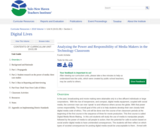
This unit is intended for students studying digital media production in the 10-12th grade. The purpose of the unit is to help students to learn from some of the positive uses and negative uses of media. In this unit students will study the use of media to manipulate people: propaganda, followed by the power of media to call people to action, and the potential for calls-to-action based on social and or digital media to have both positive and unintended negative consequences. The students will study media bias and some potential consequences of it. The students will then reflect on which types of societal consequences for posting their digital media would be unacceptable to them. Armed with this knowledge, they will create personal standards that will empower them as unaffiliated journalists to steer clear of undesired outcomes.

It is important for students to know how to evaluate messages conveyed by the news media. Exploration of the artistic techniques used in political cartoons leads to critical questioning.
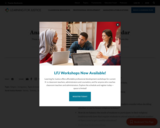
These activities ask students to engage with the question of what an equitable school calendar looks like and how to make their own school calendar more inclusive.